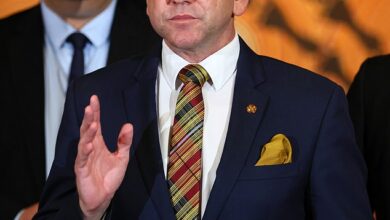The world’s most advanced helmet for fighter pilots: the futuristic Striker II device uses AR to project crucial information in front of pilots’ eyes – and can spot enemy aircraft hundreds of kilometers away

Augmented reality (AR) is already being used in everything from gaming to retail and tourism.
But the technology has been given its most important role yet: in the new Striker II fighter pilot helmet.
Developed by British defense company BAE Systems, the 2kg device presents ‘mission-critical’ data before a pilot’s eyes, giving him ‘unparalleled situational awareness’ as he patrols the skies.
From hundreds of miles away, it can distinguish between another RAF fighter pilot and a hostile enemy aircraft, such as a Chinese spy drone.
In a real defense environment, the technology could help fighter pilots take down such a threat, helping to protect British airspace.
The RAF has paid £40 million to equip its personnel with the Striker II helmet, of which fewer than 100 currently exist.
BAE Systems calls it “the world’s most advanced helmet-mounted display” that “instantly calculates the pilot’s exact head position and angle.”
At BAE Systems’ offices in Rochester, Kent, MailOnline’s Jonathan Chadwick was given exclusive access to try out Striker II on a simulated flight from RAF Valley in Anglesey, Wales.

Augmented reality (AR) is already being used in everything from gaming to retail and tourism. But the technology has taken on its most important role yet in the new Striker II fighter pilot helmet

At BAE Systems’ offices in Rochester, Kent, MailOnline’s Jonathan Chadwick was given exclusive access to try out Striker II on a simulated flight from RAF Valley in Anglesey, Wales
Nigel Kidd, director of head-mounted displays at BAE Systems, worked on the original Striker helmet, developed in the late 1990s.
This new version presents ‘more information in a sharper format’, including colored symbols – beyond the typical monochrome green – and integrated night vision, all in a 40-degree field of view.
“First and foremost, Striker II is a helmet – it keeps pilots safe,” Kidd told me as I stepped into the flight simulator, modeled after a Typhoon aircraft cockpit.
“But it’s not just a helmet – it’s a very powerful augmented reality display system.”
While Kidd won’t reveal the exact production price of the Striker II, he admits that each individual helmet “comes at a premium.”
‘The average person would probably buy a small house for what this would cost,’ he told MailOnline.
The Striker II, which is strapped to the inside of the cockpit, is made of carbon fiber and weighs about 2kg, so it feels quite heavy when I place it above my head.
I can’t imagine wearing it for several hours, especially during high-speed flights – although I’ve been told it’s light compared to other combat helmets.

A simulator shows the Typhoon aircraft based at RAF Valley before take-off. This system is used for pilot training

BAE Systems was awarded £40 million to develop Striker II for RAF pilots, although the company will not reveal the cost of each individual helmet. Currently fewer than 100 exist

Shown is the view while wearing the helmet, with speed shown on the left and altitude on the right. Notice the colored shapes, which indicate objects in the air and on the ground
Using optical sensors embedded in the aircraft, Striker II instantly calculates the position and angle of the pilot’s head.
This means that wherever the pilot looks – left, right, up or down – the display is always right in front of his eyes.
I pull down the crosshairs and see a collection of green lines, numbers and symbols, including a crosshair in the center and a long horizon line through the center.
As I take off from RAF Valley, a stack of changing numbers on the left shows my speed, while another stack on the right shows altitude.
But in addition to the green markings, there are also many shapes in all kinds of additional colors: red, blue and yellow.
These shapes indicate relevant objects in the sky and on the ground, which are constantly detected by a vast network of devices, including drones and radar towers, and send signals back to my aircraft.
On the display, different colors correspond to the nature of the object. So threats are shown in red, while ‘friendlies’ are in blue and unknowns are in yellow.
Amazingly, when I move my head and focus on one of these colored shapes, a little pop-up video clip appears, showing more about what the object actually is.

Striker II comes with digital night vision (pictured), meaning pilots no longer need to attach night vision goggles to the helmet when flying in the wee hours

Using optical sensors embedded in the aircraft, Striker II instantly calculates the pilot’s exact head position and angle
For example, I see a short clip playing on a loop of ‘friendly’ trucks driving over the ground – a clip that in real life would probably have been filmed by a nearby drone.
As my plane flies over rural Nottinghamshire, I stick my smartphone between my face and the visor, expecting to snap a photo of the colorful display.
But to my surprise it doesn’t work: my camera app only shows an empty crosshair.
This is because the AR display is projected onto the visor and reflected into my eyeballs, not into my phone’s camera lens!
It’s probably as close as the RAF will ever get to fitting their pilots with eye implants.
Striker II also comes with digital night vision, meaning pilots no longer need to attach night vision goggles to the front of the helmet as with Striker I.
This was an experience Kidd describes as “a sack of potatoes hanging from the front of your head,” making neck pain a real possibility.
I expected the Striker II’s AR display to be more distracting than helpful, presenting the pilot with a barrage of information that could distract from the flight path.

Striker II supports picture-in-picture technology that displays images in a small offset window separate from that of the main screen

In the simulator cockpit, the pilot is shown additional statistics, including a map of the flight path

RAF pilots will carry Striker II when flying Typhoon (pictured), the aircraft manufactured by German firm Eurofighter
But in reality, Striker II only shows a pilot the most important data he needs to fly the aircraft.
This is augmented reality in its purest form: helpful yet subtle and unobtrusive.
Overall, a key benefit of this technology is that pilots spend more time with their heads up and looking out of the cockpit, and not at the controls.
According to BAE Systems, this gives them ‘an essential advantage’ when it comes to split-second decision-making.
Last year the company received £40 million to develop the Striker II for RAF pilots flying the Typhoon, the aircraft made by German firm Eurofighter.
The Striker II is still undergoing flight testing with the RAF before it will be used by frontline Typhoon pilots.
Kidd told me the helmet is also being made available to other Typhoon users in Europe – namely Spain, Italy and Germany – but he admitted there is “interest from other countries.”
The Eurofighter Typhoon frontline fleet provides air security over Britain and its allies 24/7, 365 days a year.




